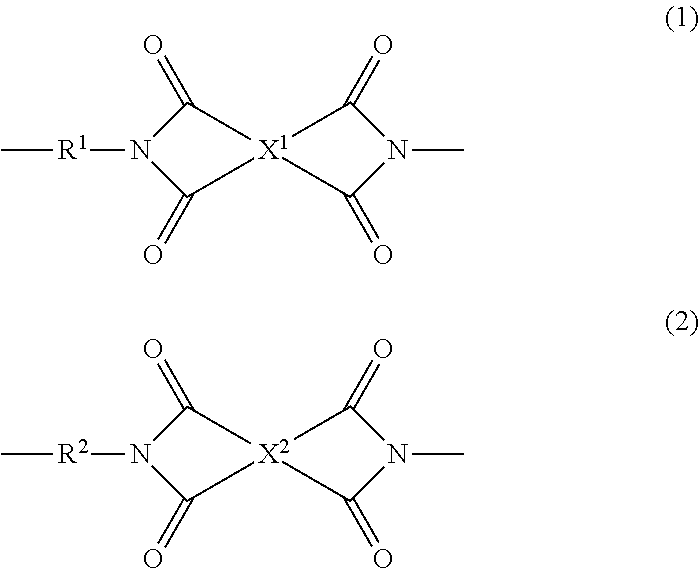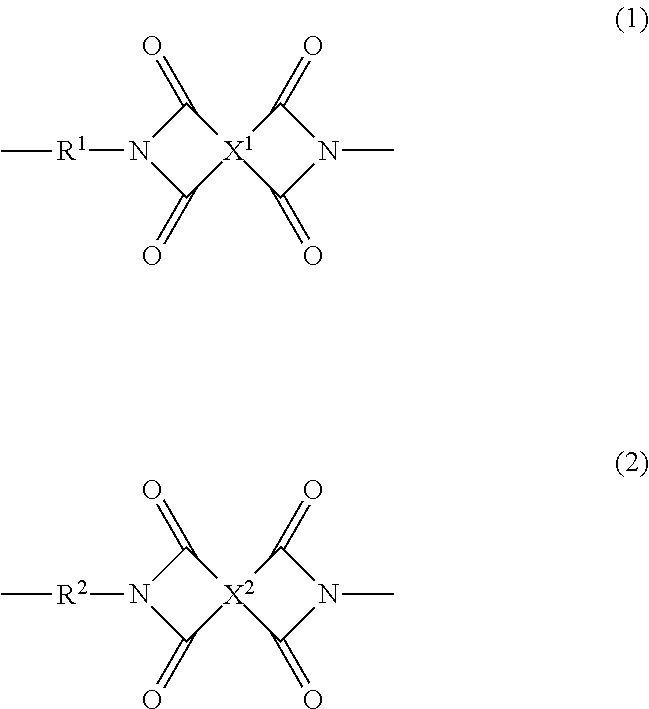Polyimide resin
a technology of polyimide resin and polyimide, which is applied in the direction of synthetic resin layered products, tyre parts, water-setting substance layered products, etc., can solve the problems of insufficient transparency of films, inability to say good transparency, and strong yellowing of films, etc., to achieve good film transparency and heat resistance, low coefficient of linear thermal expansion, and good film
- Summary
- Abstract
- Description
- Claims
- Application Information
AI Technical Summary
Benefits of technology
Problems solved by technology
Method used
Image
Examples
production example 1
Synthesis of 1,2,4,5-cyclohexanetetracarboxylic dianhydride
[0144]552 g of pyromellitic acid, 200 g of a catalyst of rhodium held on active carbon (manufactured by N.E. Chemcat Corporation), and 1656 g of water were put into a hastelloy (HC22) autoclave having an inner volume of 5 liters, and while stirring, the reactor was purged with nitrogen gas. Next, the reactor was purged with hydrogen gas so that the hydrogen pressure in the reactor could be 5.0 MPa, and heated up to 60° C. While the hydrogen pressure was kept at 5.0 MPa, this was reacted for 2 hours. The hydrogen gas in the reactor was purged with nitrogen gas, and the reaction liquid was taken out of the autoclave. The reaction liquid was filtered at a hot state to separate the catalyst from a filtrate. The filtrate was concentrated by evaporating water under reduced pressure with a rotary evaporator, thereby precipitating a crystal. The precipitated crystal was separated through solid-liquid separation at room temperature a...
example 1
[0146]In a nitrogen stream atmosphere, 14.565 g (0.045 mol) of 2,2′-bis(trifluoromethyl)benzidine, and, as a solvent, 62.42 g of γ-butyrolactone and 26.75 g of N,N-dimethylacetamide were put into a 500-mL five-neck flask equipped with a thermometer, a stirrer, a nitrogen-introducing duct, a side tube-having dropping funnel, a Dean Stark unit and a condenser, and dissolved therein. 4.075 g (0.018 mol) of 1,2,4,5-cyclohexanetetracarboxylic dianhydride synthesized in Production Example 1 and 8.027 g (0.027 mol) of 3,3′,4,4′-biphenyltetracarboxylic dianhydride and, as an imidation catalyst, 0.92 g (0.05 mol) of triethylamine were added thereto all at a time. After the addition, this was heated up to 170° C., and refluxed for 5 hours while the distillate was removed as needed. The finish of water distillation was confirmed, and this was cooled to 120° C. 135.82 g of N,N-dimethylacetamide was added thereto, and stirred and mixed for 2 hours to obtain a polyimide resin solution.
[0147]Subse...
example 2
[0148]In a nitrogen stream atmosphere, 14.752 g (0.046 mol) of 2,2′-bis(trifluoromethyl)benzidine, and, as a solvent, 62.20 g of γ-butyrolactone were put into a 500-mL five-neck flask equipped with a thermometer, a stirrer, a nitrogen-introducing duct, a side tube-having dropping funnel, a Dean Stark unit and a condenser, and dissolved therein, and then 5.159 g (0.023 mol) of 1,2,4,5-cyclohexanetetracarboxylic dianhydride synthesized in Production Example 1 and 6.775 g (0.023 mol) of 3,3′,4,4′-biphenyltetracarboxylic dianhydride and, as an imidation catalyst, 1.16 g (0.05 mol) of triethylamine were added thereto all at a time. After the dropwise addition, this was heated up to 170° C., and refluxed for 5 hours while the distillate was removed as needed. The finish of water distillation was confirmed, and this was cooled to 120° C. 162.8 g of N,N-dimethylacetamide was added thereto, and stirred and mixed for 2 hours to obtain a polyimide resin solution.
[0149]Subsequently, the resulta...
PUM
| Property | Measurement | Unit |
|---|---|---|
| Thickness | aaaaa | aaaaa |
| Particle size | aaaaa | aaaaa |
| Transmittivity | aaaaa | aaaaa |
Abstract
Description
Claims
Application Information
 Login to View More
Login to View More - Generate Ideas
- Intellectual Property
- Life Sciences
- Materials
- Tech Scout
- Unparalleled Data Quality
- Higher Quality Content
- 60% Fewer Hallucinations
Browse by: Latest US Patents, China's latest patents, Technical Efficacy Thesaurus, Application Domain, Technology Topic, Popular Technical Reports.
© 2025 PatSnap. All rights reserved.Legal|Privacy policy|Modern Slavery Act Transparency Statement|Sitemap|About US| Contact US: help@patsnap.com



